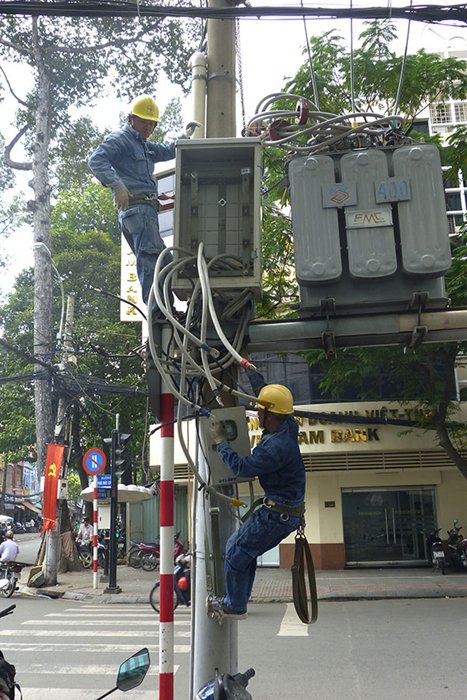Deputy Prime Minister Trinh Dinh Dung has voiced concern over the possible shortage of electricity in southern Vietnam given the rising demand, heard a conference of the Vietnam Electricity Group (EVN) on January 4.

Two electricity workers are seen working at an exterior transformer station in downtown HCMC. Deputy Prime Minister Trinh Dinh Dung has voiced concern over the possible shortage of electricity in southern Vietnam
The demand for electricity is forecast to rise steeply while hydroelectricity which accounts for around 40% of the country’s power output has less room for more growth, Dung said.
Therefore, Vietnam has no way but to develop alternative energy sources. However, the development of renewable energy has yet to be on a large scale due to high production costs.
“Thermal power plants, especially coal-fired ones, are still the main source of electricity between now and 2030, or even from the 2030s onwards,” he said. The electricity sector is under pressure from the imbalance between supply and demand, he added.
In particular, the northern, central, and southern regions of the country make up around 40%, 10% and 50% of the electricity demand respectively.
However, the power supply in the northern part represents the highest proportion, more than 50%, while the figure for the southern part is less than 40%. Therefore, a shortage of electricity in large areas in the south is still a major concern for the sector.
“The southern part of the country is at risk of lacking electricity this year if work on (power) plants is behind schedule,” he warned.
He added high investment costs and investors’ incompetence are hindering the development of energy sources. Rising public debts have made it harder to raise funds for power projects.
According to EVN, it is increasingly difficult to ask for allocation of capital for these projects as the Government has suspended its credit guarantee policy while EVN and its subsidiaries have beat their borrowing caps.
The group said natural disasters and abnormal weather had led to over VND600 billion (US$26.4 million) in damage for its power system.
Higher prices of coal and gas for electricity generation, water resource tax, and forest environmental service fees have also hampered the financing of power projects.
EVN’s electricity sales were estimated at more than VND289.25 trillion (US$12.7 billion) last year, a year-on-year rise of 8.9% against 2016. Its commercial power output was 174.05 billion kWh, up 8.9%.
SGT